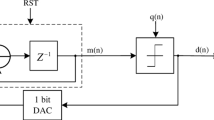Abstract
In the system of MEMS digital geophone, the mechanical sensing element and post-stage detection circuit are combined to work as the Sigma-Delta (ΣΔ) modulator. The performance of ΣΔ modulator can be improved by cascading electrical integrators behind the sensitive structure. Thus, additional integrators are introduced in series with the mechanical sensing element to form the high order ΣΔ modulator. In fact, the increase of the system order of ΣΔ modulator is limited to maximum 5 or 6 order due to the system instability. In other words, the stability of ΣΔ modulator system will be weaken caused by the phase loss from the additive integrators. This paper proposes a fractional-order zero-phase integrator (FOZPI) that in series with the 5th-order ΣΔ modulator to effectively suppress the phase distortion in the noise-shaping process for MEMS digital geophone. The proposed ΣΔ modulator with the FOZPI applies in MEMS digital geophone can better enhance the compromise capability between the high signal to noise ratio (SNR) and strong robust stability than the pure 5th-order ΣΔ modulator does. The order of FOZPI is designed by using swarm intelligent algorithm, which offers opportunity to simplify the process of tuning parameter and further improve the noise performance. Finally, the simulation results show that the proposed ΣΔ modulator with FOZPI scheme is an effective way to improve the performance and loop stability for ΣΔ modulator.












Similar content being viewed by others
References
Gannon, J., et al. (1999). A seismic test facility. In Meeting of the society of exploration geophysicists. New Orleans, LA, November 1.
Lu, C.-C., & Hou-Ming, C. (2018). SC amplifier and SC integrator with enhanced immunity to capacitor mismatch. Analog Integrated Circuits Signal Processing, 96, 1–11.
Bafandeh, A., & Yavari, M. (2016). Digital calibration of amplifier finite DC gain and gain bandwidth in MASH ΣΔ modulators. IEEE Transactions on Circuits and Systems II: Express Briefs, 63(4), 321–325.
Lin, H., Zhang, Y., Long, F., Mei, F., Yu, M., Lin, F., et al. (2014). Digital noise-coupling technique for delta-sigma modulators with segmented quantization. IEEE Transactions on Circuits and Systems II: Express Briefs, 61(6), 403–407.
Aminzadeh, H. (2018). Study of capacitance nonlinearity in nano-scale multi-stage MOSFET-only sigma-delta modulators. AEU-International Journal of Electronics and Communications, 85, 150–158.
Aminzadeh, H. (2018). Digital extraction of quantization error and its applications to successful design of sigma-delta modulator. Analog Integrated Circuits and Signal Processing, 94(3), 413–425.
Kajita, T., Un-Ku, M., & Temes, G. C. (2002). A two-chip interface for a MEMS accelerometer. IEEE Transactions on Instrumentation and Measurement, 51(4), 853–858.
Dong, Y., Kraft, M., & Gollasch, C. O. (2004). A high performance accelerometer with fifth order-modulator. In Proceedings of the MEW, Leuven, BE, (pp. 41–44).
Lang, C., Tielert, R. (1999). A low noise accelerometer with digital PID-type controller and multibit force feedback. In Proceedings of the ES-SCC, Duisburg, GER, (pp. 250–253).
Jung, Y., & Temes, G. C. (2018). Optimal dynamic range scaling of Sigma-Delta ADC using bias current estimation. Analog Integrated Circuits and Signal Processing, 94(3), 405–412.
Gannon, J., et al. (1999). A seismic test facility. In Meeting of the society of exploration geophysicists. New Orleans, LA, November 1.
Ortigueira, M. D. (2006) Riesz potential operators and inverses via fractional centred derivatives. International Journal of Mathematics and Mathematical Sciences, 1–12.
Monje, C. A., Chen, Y., Vinagre, B. M., Xue, D., & Feliu-Batlle, V. (201). Fractional-order systems and controls. Advances in Industrial Control.
Shen, H., Chen, Y. Q., & Qiu, T. S. (2012). Fractional processes and fractional order signal processing. Berlin: Springer.
Ortigueira, M. D. (2011). Fractional calculus for scientists and engineers. New York: Springer.
Ye, Y. Q., Pan, X., & Wang, J. H. (2012). Identification of blur parameters of motion blurred image using fractional order derivative. In The 11th international conference on information science, signal processing and their applications (Vol. 12, No. 2, pp. 539–544).
Psychalinos, C., Elwakil, A., Maundy, B., & Allagui, A. (2016). Analysis and realization of a switched fractional-order-capacitor integrator. International Journal of Circuit Theory and Applications, 44(11), 2035–2040.
Oldham, K., & Spanier, J. (1974). The fractional calculus: Theory and application of differentiation and integration to arbitrary order. New York: Academic.
Hilfer, R. (Ed.). (2001). Applications of fractional calculus in physics. Hackensack, NJ: World Scientific.
Oustaloup, A., et al. (2000). Frequency-band complex noninteger differentiator: Characterization and synthesis. IEEE Transactions on Circuits and Systems I: Fundamental Theory and Applications, 47(1), 25–39.
Tricaud, C., & Chen, Y. Q. (2010). An approximate method for numerically solving fractional order optimal control problems of general form. Computers and Mathematics with Applications, 59(5), 1644–1655.
Vinagre, B. M., Podlubny, I., Hernandez, A., & Feliu, V. (2000). Some approximations of fractional order operators used in control theory and applications. Fractional Calculus Applied Analysis, 3(9), 231–248.
Sun, H. H., Abdelwahad, A. A., & Onaral, B. (1984). Linear approximation of transfer function with a pole of fractional order. IEEE Transactions on Automatic Control, AC-29(5), 441–444.
Kennedy, R. E. (1995). Particle swarm optimization. In IEEE conference on neural networks, (pp. 1942–1948). Perth.
Deng, Wu, Zhao, Huimin, Yang, Xinhua, Xiong, Juxia, Sun, Meng, & Li, Bo. (2017). Study on an improved adaptive PSO algorithm for solving multi-objective gate assignment. Applied Soft Computing, 59, 288–302.
Acknowledgements
This work was supported by the research fund to the top scientific and technological innovation team from Beijing University of Chemical Technology (No. buctylkjcx06).
Author information
Authors and Affiliations
Corresponding author
Additional information
Publisher's Note
Springer Nature remains neutral with regard to jurisdictional claims in published maps and institutional affiliations.
Rights and permissions
About this article
Cite this article
Xu, C., Jin, Y., Yu, D. et al. A fractional-order zero-phase integrator for sigma-delta modulator. Analog Integr Circ Sig Process 100, 335–343 (2019). https://doi.org/10.1007/s10470-019-01458-2
Received:
Revised:
Accepted:
Published:
Issue Date:
DOI: https://doi.org/10.1007/s10470-019-01458-2




